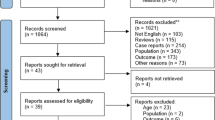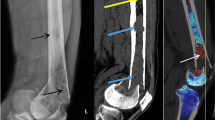Abstract
Introduction
As the average age of society increases, so does the number of cases of fragility fractures of the pelvis (FFP). Magnetic resonance imaging (MRI) can visualise associated oedema and is thus the gold standard for diagnosing such fractures. MRI, however, is costly, not always available, and involves certain exclusion criteria. Dual-energy computed tomography (DECT) appears to be a promising alternative. It is unclear, however, whether it could be used for diagnosing FFP with similar sensitivity/specificity. The aim of our study was thus to compare conventional CT and DECT with MRI in cases of suspected FFP.
Materials and methods
A total of 46 patients with suspected FFP underwent MRI, CT and DECT scans. There were three comparison groups for each of these patients: conventional CT image analysis without dual-energy modification (Arm 1), DECT analysis (Arm 2) and MRI as the gold standard (Arm 3). Diagnosis and FFP classification were performed by a radiologist in random order and without clinical information. The sensitivity and specificity of conventional CT and DECT were calculated in comparison with MRI as the reference standard.
Results
With 100% sensitivity and specificity, DECT is on par with MRI when it comes to diagnosing fragility fractures of the pelvis and is superior to conventional CT (90.3% sensitivity, 100% specificity). In terms of classification as well, there were no differences between DECT and MRI. On conventional CT, on the other hand, 16 patients were classified differently than they were on MRI.
Conclusions
Our study shows DECT to be reliable and superior to conventional CT in terms of oedema detection and specific fracture classification in FFP. DECT thus combines the advantages of conventional CT (good visualisation of bone matter) and MRI (medullary cavity and visualisation of occult fractures).





Similar content being viewed by others
References
Oberkircher L, Ruchholtz S, Rommens PM, Hofmann A, Bücking B, Krüger A (2018) Osteoporotic pelvic fractures. Dtsch Arztebl Int 115:70–80
Fuchs T, Rottbeck U, Hofbauer V, Raschke M, Stange R (2011) Pelvic ring fractures in the elderly. Underestimated osteoporotic fracture Der Unfallchirurg 114:663–670
Rommens PM, Wagner D, Hofmann A (2012) Osteoporotic fractures of the pelvic ring. Zeitschrift für Orthopädie und Unfallchirurgie 150:107–120
Rommens PM, Hofmann A (2013) Comprehensive classification of fragility fractures of the pelvic ring: recommendations for surgical treatment. Inj Int J Care Inj 44:1733–1744
Hackenbroch C, Riesner HJ, Lang P, Stuby F, Danz B, Friemert B, Palm HG, AG Becken III der Deutschen Gesellschaft für Unfallchirurgie (2016) Dual energy CT: a novel technique for diagnostic testing of fragility fractures of the pelvis. Zeitschrift für Orthopädie und Unfallchirurgie 155:27–34
Ruchholtz S, Bücking B, Schulz R-J (2016) Becken. Alterstraumatologie, 1st edn. Thieme Verlagsgruppe, Stuttgart, pp 296–318
Lourie H (1986) Spontaneous osteoporotic fracture of the sacrum. An unrecognized syndrome of the elderly. JAMA 248:715–717
Stuby FM, Schaffler A, Haas T, Konig B, Stockle U, Freude T (2013) Insufficiency fractures of the pelvic ring. Der Unfallchirurg 116:351–366
Tile M (1988) Pelvic ring fractures: should they be fixed? J Bone Jt Surg 70:1–12
Imhof H, Halpern B, Herneth A (2006) Pareto-Reihe Radiologie Wirbelsäule. Thieme Verlagsgruppe, Stuttgart
Cabarrus MC, Ambekar A, Lu Y, Link TM (2008) MRI and CT of insufficiency fractures of the pelvis and the proximal femur. Am J Roentgenol 191:995–1001
Soles GL, Ferguson TA (2012) Fragility fractures of the pelvis. Curr Rev Musculoskel Med 5:222–228
Henes FO, Nuchtern JV, Groth M, Habermann CR, Regier M, Rueger JM, Adam G, Grossterlinden LG (2012) Comparison of diagnostic accuracy of magnetic resonance imaging and multidetector computed tomography in the detection of pelvic fractures. Eur J Radiol 81:2337–2342
Grangier C, Garcia J, Howarth NR, May M, Rossier P (1997) Role of MRI in the diagnosis of insufficiency fractures of the sacrum and acetabular roof. Skelet Radiol 26:517–524
Peh WC, Khong PL, Yin Y, Ho WY, Evans NS, Gilula LA, Yeung HW, Davies AM (1996) Imaging of pelvic insufficiency fractures. Radiographics 16:35–48
Kaup M, Wichmann J, Scholtz J, Beeres M, Kromen W, Albrecht MH, Lehnert T, Boettcher M, Vogl TJ, Bauer R (2016) Dual-energy CT-based display of bone marrow edema in osteoporotic vertebral compression fractures: impact on diagnostic accuracy of radiologists with varying levels of experience in correlation to mr imaging. Radiology 29:150472
Wagner D, Ossendorf C, Gruszka D, Hofmann A, Rommens PM (2015) Fragility fractures of the sacrum: how to identify and when to treat surgically? Eur J Trauma Emerg Surg 41:349–362
Hackenbroch C, Riesner HJ, Lang P, Stuby F, Beer M, Friemert B, Palm HG, Becken AG III (2017) Die dual-energy-computertomographie in der muskuloskeletalen radiologie mit fokus auf Insuffizienzfrakturen des beckens. Z Orthop Unfall 155:708–715
Thiryayi WA, Thiryayi SA, Freemont AJ, Klestil T, Kreczy A (2008) Histopathological perspective on bone marrow oedema, reactive bone change and haemorrhage. Eur J Radiol 67:62–67
Rangger C, Kathrein A, Freund MC, Klestil T, Kreczy A (1998) Bone bruise of the knee: histology and cryosections in 5 cases. Acta Orthop Scand 69:291–294
Tins BJ, Garton M, Cassar-Pullicino VN, Tyrrell PN, Lalam R, Singh J (2015) Stress fracture of the pelvis and lower limbs including atypical femoral fractures-a review. Insights Imaging 6:97–110
Ishibashi Y, Okamura Y, Otsuka H, Nishizawa K, Sasaki T, Toh S (2002) Comparison of scintigraphy and magnetic resonance imaging for stress injuries of bone. Clin J Sport Med 12:79–84
Spiegl U, Schnake K, Osterhoff G, Scheyerer M, Ullrich B, Bula P, Siekmann H (2018) Radiologische diagnostik von stress- und insuffizienzfrakturen des sakrums. Orthopädie und Unfallchirurgie. https://doi.org/10.1055/a-0640-8933
Schmitz P, Baumann F, Grechenig S, Gaensslen A, Nerlich M, Müller M (2015) The cement-augmented transiliacal internal fixator (caTIFI): an innovative surgical technique for stabilization of fragility fractures of the pelvis. Injury 46:114–120
Author information
Authors and Affiliations
Corresponding author
Ethics declarations
Conflict of interest
The authors declare that they have no conflict of interest.
Additional information
Publisher's Note
Springer Nature remains neutral with regard to jurisdictional claims in published maps and institutional affiliations.
Rights and permissions
About this article
Cite this article
Palm, HG., Lang, P., Hackenbroch, C. et al. Dual-energy CT as an innovative method for diagnosing fragility fractures of the pelvic ring: a retrospective comparison with MRI as the gold standard. Arch Orthop Trauma Surg 140, 473–480 (2020). https://doi.org/10.1007/s00402-019-03283-8
Received:
Published:
Issue Date:
DOI: https://doi.org/10.1007/s00402-019-03283-8




